Probe thermometers: features, types, selection, operation

A kitchen thermometer is one of the first things you need to buy when setting up your kitchen. It may seem that there is nowhere to use it especially and that it is required only for beginners or for chefs who are not confident in their abilities, but this is not at all the case. When preparing certain dishes, the thermometer can help you bring them to the required level of readiness and serve them exactly as intended.
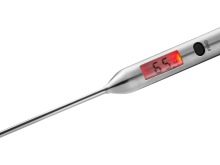

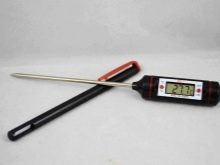
What it is?
A probe thermometer (temperature probe) is a device used to monitor the temperature of food ingredients. He is an excellent assistant if, when preparing a dish, it is necessary to strictly adhere to all the rules in order to get the desired result. The long metal probe makes it possible to find out the readiness of the dish in the middle, and not only on the outside. Most of all, this is important for large pieces of meat, desserts or fish.
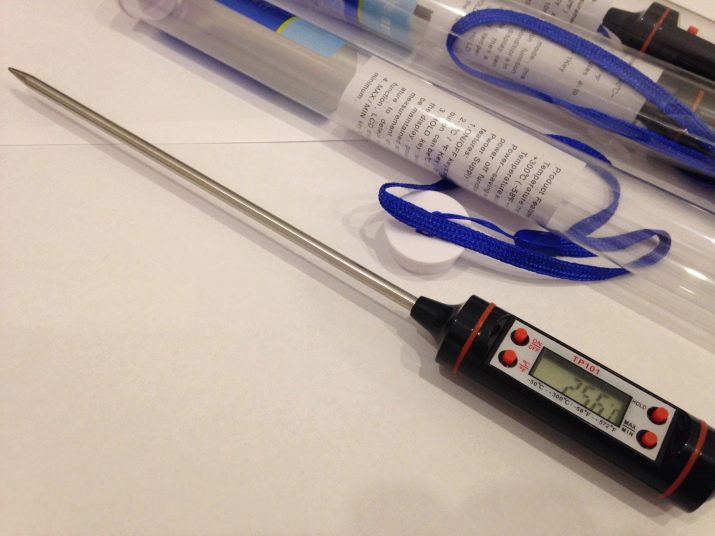
Varieties
There are 2 key types of thermometers: digital (electronic) and analog. Electronic appliances are a great choice for people who are serious and meticulous about their food preparation.
Analog ones are useful for those who do not need high accuracy and who want to save money on their purchase.
Analog (they are mechanical, bimetallic, spring, switch) The thermometers are equipped with a stainless steel probe (from 8 to 20 centimeters) with a built-in measuring element in the tip. This type of device functions by the method of expansion of bodies from an increase in temperature. There are 2 scale options.
- In one, when the metal is heated, the arrow of the device is displaced; from the outside, the dial is similar to a clock. The sensor is usually a steel coil or a bimetal plate.
- The second type is also similar to a watch, only instead of the traditional hand, a tube with a colored liquid is used as a scale. As the temperature of the dish rises, the liquid expands and the scale rises upward. The opposite effect occurs on cooling.
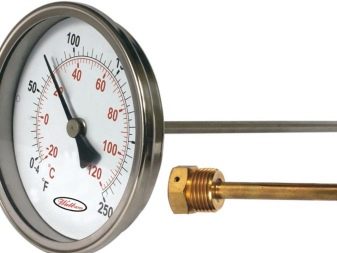
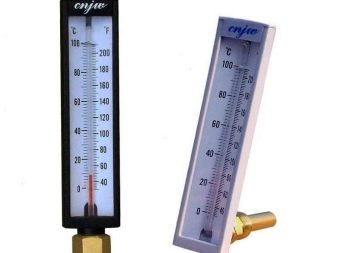
There are a huge number of varieties of digital temperature probes, but we will focus on two main ones.
- Standard digital thermometer (it is also called a temperature probe, a thermometer with a probe, a needle thermometer). This device is very popular. It is a small electronic unit with a display and a thin metal probe in the form of a needle, which is immersed in the food. The accuracy of its measurements is quite high, it determines the temperature quite quickly, and the only drawback is the excess of plastic elements, which is why it should not be used at extremely high temperatures. Of his “comrades”, he is the most budgetary, since he does not have any auxiliary functions.
For housewives who do not intend to measure the temperature of dishes in the oven, this device is quite enough.
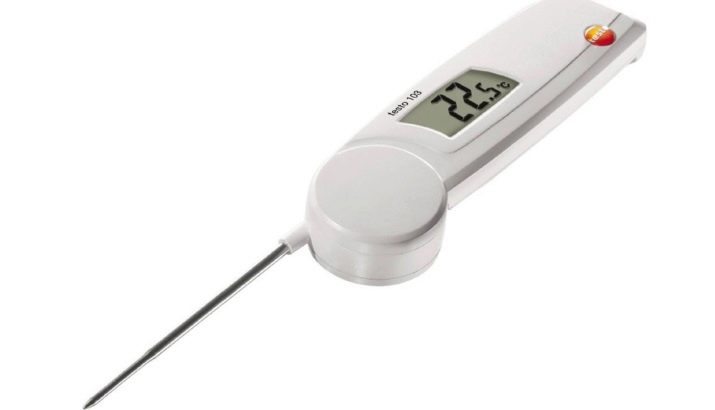
- With an external probe. A device of this type is needed for chefs who prefer to cook in the oven. The culinary core probe is not equipped with a rigidly fixed needle, but with a separate needle on a flexible stainless steel wire. It extends to the inside of the oven, where the thorn sinks into the food. The device itself remains outside. Meat and pastry will be cooked under control for as long as it takes to bake the dish flawlessly.
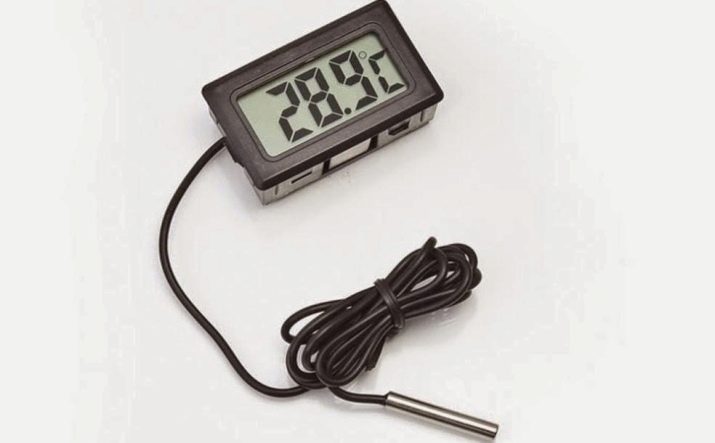
A thermometer with an external probe costs 2-3 times more than conventional samples, but along with this, it has a lot of auxiliary options. You can set a timer on it, as well as make settings for the sensor, which will work when the food is completely ready. The buzzer will inform the owner that it is time to take out the baking sheet.
Certain modifications make it possible to set the mode based on the type of prepared dish.
Due to the elasticity of the wire, the probe can be placed in the most difficult-to-reach areas. Additionally, the device can be used for barbecue, grill and smokehouse cooking. Believe it or not, the device can be used to measure the temperature of a concrete solution and the like.

Infrared thermometers (pyrometers, IR thermometers, non-contact thermometers) are the most modern devices, they set the temperature on the outside of objects. These devices make measurements based on the intensity of the emitted thermal radiation. Not every housewife will need a kitchen device of this direction, since it cannot be used to measure the temperature in the depths of the dish being prepared.
However, it is comfortable for measuring the heat of those dishes, whose casing should not be damaged by punctures. In addition, an infrared thermometer can be used to measure the temperature of empty heated dishes. It is practical if the recipe requires the food to be fried at a specific temperature.
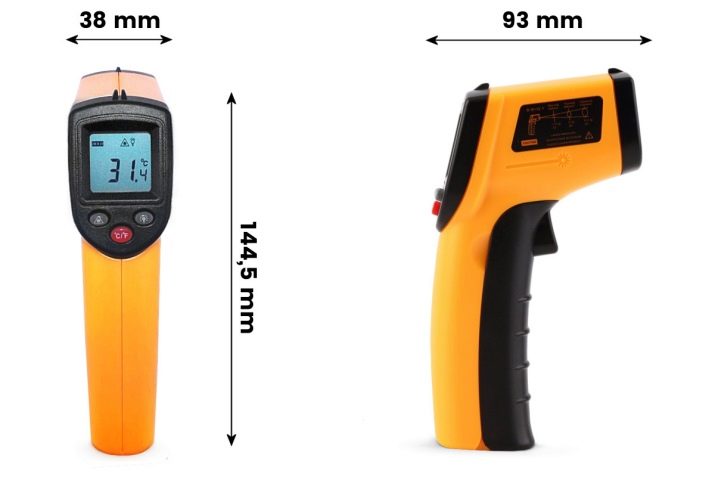
Compared to all thermometers described above, this modification displays the measurement result instantly.
But it should be noted that the farther it is from the tested object, the greater the deviation becomes.
Advantages and disadvantages
Analog thermometers
Advantages:
- relatively low cost;
- ease of use;
- just wash;
- the device is equipped with a clip for fixing on the pan;
- functions without a battery or other batteries.
Disadvantages:
- measurement accuracy fluctuates within a few degrees;
- imperfect scale scale - as a rule, it is very narrow, which makes it possible to use it only for a small number of dishes;
- to correctly identify the temperature, you must wait for the heating of the probe;
- with careless use (falling, impacts), the deviation of measurements increases;
- it is necessary to clean the probe after any measurement;
- damages the structure of the dish when measured.

Electronic (digital) device
Advantages:
- high accuracy of measurements;
- scale scale - from -50 to +300 degrees;
- have auxiliary options - backlight, buzzer (sound signal when the required temperature is obtained).
Disadvantages:
- an abundance of plastic elements that can melt at too high temperatures or become unusable during cleaning;
- to accurately establish the temperature, you need to wait until the probe heats up;
- you need to clean the probe after any measurement;
- damage to the structure of the dish during measurements;
- operates on battery power.
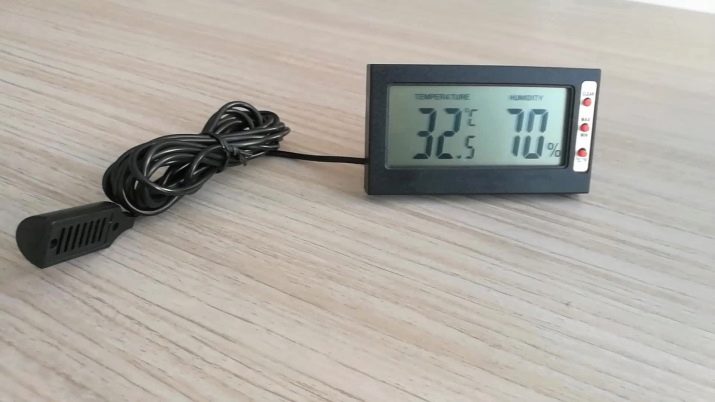
IR thermometer
Advantages:
- instant temperature detection, no need to wait for the probe to warm up, you just need to point the device at the product in order to find out its temperature;
- measuring the temperature at a distance of several meters, which simplifies the work with hot dishes;
- it is not necessary to constantly wash and clean the appliance, since it does not have contact with food, which greatly increases the service life of the appliance;
- high-precision - determines the temperature with a small deviation;
- wide scale, which makes it possible to measure the temperature not only of hot dishes, but also to use it when freezing;
- no need to pierce the dish, damaging its shell;
- additional options - fixing the temperature of the last measurement, intense screen backlighting, auto power off, measures both in Celsius and Fahrenheit;
- can be used both in the kitchen and in everyday life, for example, by means of it it is easy to measure the temperature of a battery, water in a bath or a tap.
Disadvantages:
- high price;
- it is impossible to measure the temperature in the depth of the prepared dish;
- operates on batteries.
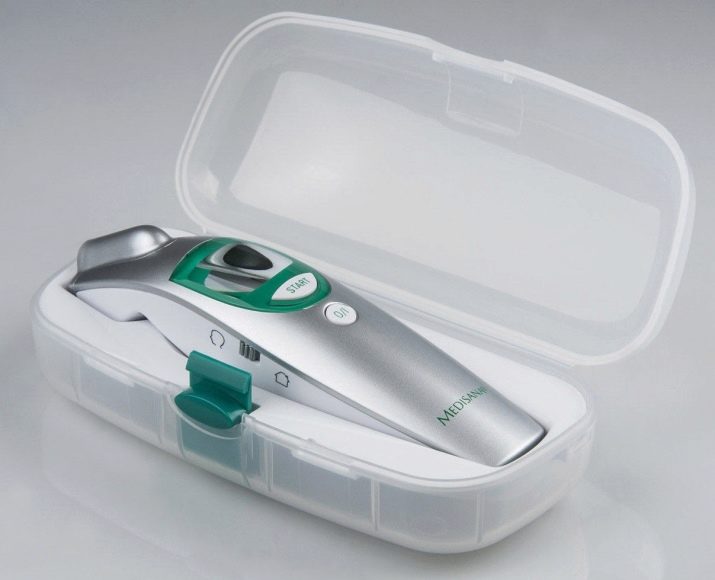
Manufacturers overview
Chinese marketplaces are inundated with advertisements for cheap devices, but they can be used when the device is needed a couple of times. If the attitude to measurement is professional, then it is worth contacting specialists for the device.
- ThermoWorks - this company produces exclusively thermometers. Produces various modifications, they are all connected by high cost and excellent quality.
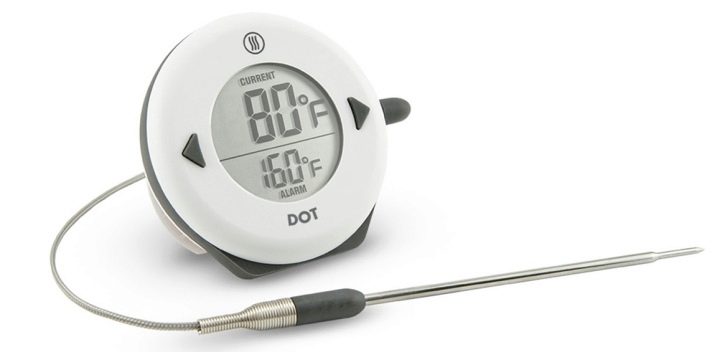
- Weber - a company that has been operating for over 100 years. It is engaged in the production of grills, smoking devices. Thermometers in this case are a related product.
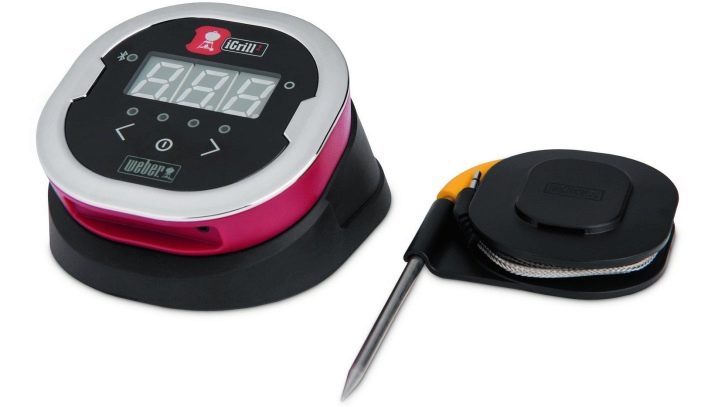
- Karl weis and co - European manufacturer. It is one of the oldest German companies for the production of steel household items. Today it is the undisputed favorite in the manufacture of equipment, cutlery and utensils for kitchens and restaurants.
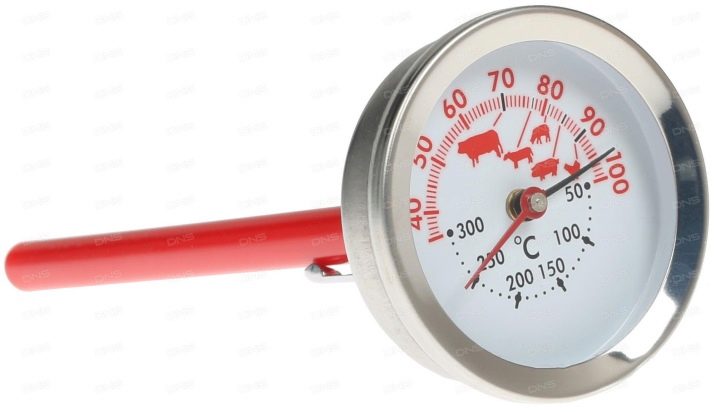
How to choose?
It is safer to purchase a kitchen thermometer for products at a stationary outlet. On the pages of Internet catalogs, there is no opportunity to hold the device in hands, examine the build quality and reliability of a thin probe.
It is advisable to refuse inexpensive digital modifications. Basically, the deviation of their indicators does not correspond to the declared one and reaches 3-5 degrees against the guaranteed tenths. It's easier to get an analog thermometer straight away.
Look for devices with the ability to correct readings.
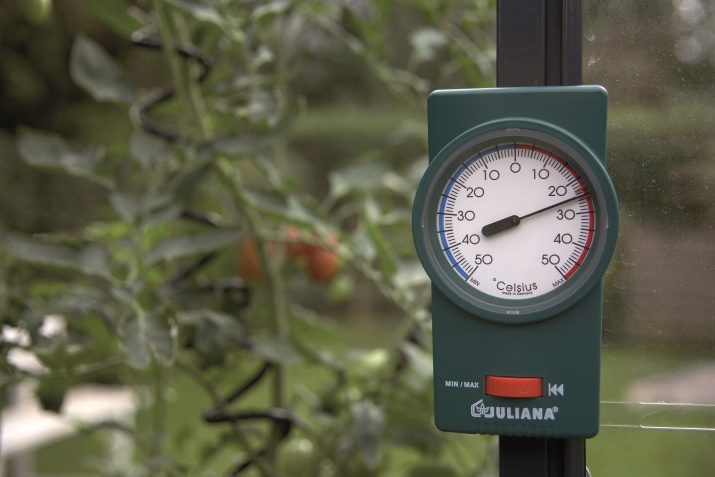
Sometimes a good-quality core temperature probe can malfunction with intensive use, but you can freely reconfigure it for subsequent use.
And one final recommendation: try to buy temperature indicators of already tested brands... These companies are much more reliable and work much longer, their devices measure the temperature of liquids, meat and pastries as accurately as possible.
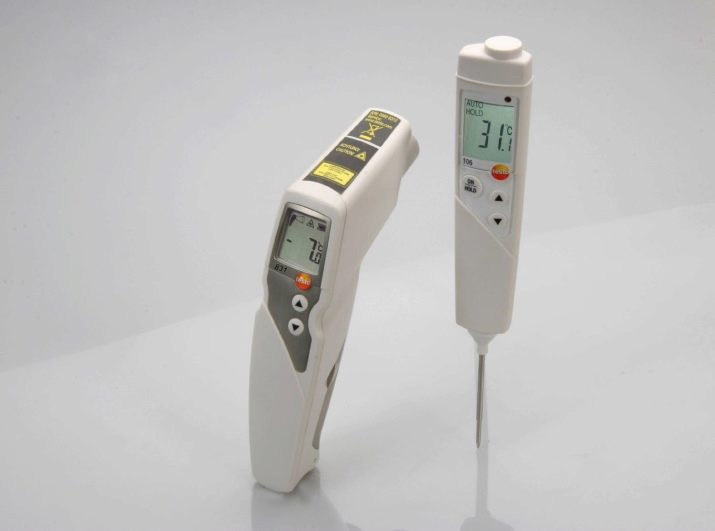
Terms of use
For any thermometer for the kitchen, the manufacturer encloses a detailed manual for its use, however, there is also a general set of requirements that are unconditional for execution.
- Only moisture-resistant accessories are allowed to be completely immersed in water or washed in it.
- You should not use the device too often, piercing the dish - this will lose its own juiciness.
- A culinary thermometer is usually used at the end of food preparation. For barbecue, this is the final 10 minutes of cooking, for whole cuts of meat, the final 15-20 minutes.
- A specialized table can help to find out the degree of readiness of the dish. It contains information about the type of product and the temperature at which it is ready for use.
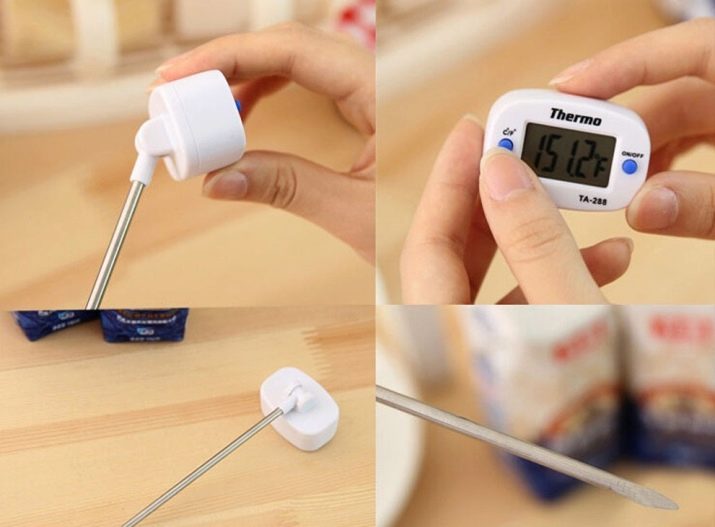
And one more thing: you should not drive the probe of the device close to bones or cartilage - this may damage it, and in addition, its readings will become unreliable, or the instrument will completely stop functioning.
Care features
It should be remembered that once every 6 months, a control verification of the accuracy of measuring the readiness of dishes should be carried out. It is permissible to clean the casing of the kitchen thermometer and its screen either with a moistened clean cloth or by means of napkins.
Submerging devices, as already mentioned, entirely in water, and especially models with a wire, is strongly prohibited.

The removable or retractable dipstick, after detaching from the casing, can be washed in warm water using a detergent. Then they wipe it dry.
After cleaning, the device is stored in a place with good ventilation, without excessive moisture and at room temperature.
There are probes even with a radio transmitter, the operating radius of which is one kilometer, but the need for this device is extremely small. The main thing you need in a kitchen thermometer - so that it gives accurate information and is convenient to use.
For an overview of the electronic probe thermometer, see below.








